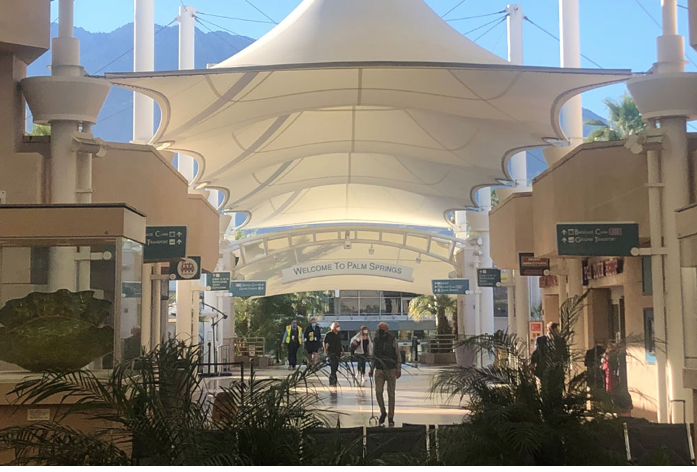CommentsAIR TRAVEL - If you’re heading to heaven, you really should fly out of Palm Springs.
I offer that line not as a jab at the advanced average age of the Coachella Valley’s retiree-heavy population. Rather, it’s a testament to the warmth and wonder I felt while waiting for a recent flight at Palm Springs International Airport.
Pandemic-era air travel in California is typically a miserable combination of unhappy passengers and unreliable service—except in Palm Springs. There, flying still feels like a miracle.
The airport is small, with fewer than two dozen gates, and easy to navigate. Security lines are often short. After your body and bags are scanned, you emerge into an outdoor desert garden, with good coffee. It might be the best waiting room in American aviation.
And, if we’re lucky, sun-splashed, open-air PSP—the code by which this airport is known—will become a model for post-pandemic flight across California, and especially in the smaller airports of our growing inland regions.
PSP is already the people’s choice. While the pandemic has grounded the ambitions of the airlines and the larger travel industry, PSP has soared. 2021 was the busiest summer in the airport’s history. And since last June, the airport has set seven new monthly records for passengers; PSP now serves more than two million people annually.
The commercial air traffic may keep setting new records. Southwest Airlines started service in Palm Springs in late 2020 and now flies from there to eight cities, including Sacramento and Oakland. Six other airlines have added flights, including American Airlines to Philadelphia, JetBlue to Fort Lauderdale, and, just last month, aha! to Reno. The 13 passenger airlines serving the airport now offer 35 different routes—creating more competition and lowering fares, and surely making PSP even more popular.
In local news reports, airport officials have expressed surprise at this pandemic surge; they hadn’t projected a return to pre-COVID numbers until 2023. But this small airport, a former military base that the city of Palm Springs bought and converted six decades ago, has long found ways to succeed, even in hard times.
Indeed, PSP has prospered ever since the Great Recession, even as other airports in California, Nevada, and Arizona have stagnated. One reason has been the large number of Canadian snowbirds buying Coachella Valley properties after the collapse of the housing bubble. That growing Canadian colony created a huge demand for flights from the Great White North. PSP now has non-stop service not just to Vancouver and Toronto, but also to Calgary, Edmonton, and Winnipeg.
Thanks in part to the Canadian influx, Palm Springs established new records for passengers in six of the seven years between 2012 and 2019.
The airport’s growth has been supported over the last two decades by the sort of careful and sustained investment that too many California localities struggle to pull off. Early in the century came a new control tower, runway enhancements, a new and larger terminal, and a remodeling of that outdoor courtyard. More recent years have seen the expansion of the ticket lobby and a new, improved baggage handling system. These additions, carefully designed, have not cost the airport its small and convenient feel.
Palm Springs can’t take all the credit for its growth. The awfulness of flying in and out of LAX, and the horror of driving anywhere from it, have driven customers to find alternatives. And Ontario Airport, the nearest Inland Empire rival to Palm Springs, has been badly mismanaged, shedding flights and passengers for most of the 2000s and 2010s.
When COVID hit, PSP, with that outdoor space, felt like a safe place to visit—not unlike Palm Springs. The Coachella Valley’s great weather, and its tradition of indoor-outdoor living, has made it a popular place to pass the pandemic.
I made my maiden voyage recently on a late afternoon flight from PSP to Oakland, after a tiring day of reporting around the valley.
Top of Form
For the first time I can remember, an airport refreshed me. I made it through security in two minutes, having to wait only for a very polite family of five, all wearing Toronto Maple Leaf sweatshirts. I lay down on a shady bench in the garden, before heading up into the Sonny Bono Concourse to grab a sandwich at an open-air restaurant. While eating, I took in fabulous views of Southern California’s two highest mountains, Mt. San Gorgonio and Mt. San Jacinto. It felt a bit like visiting a desert spa.
Marveling at the scene, I told an airport worker that the only thing missing was a swimming pool. She quickly corrected me—there is a pool, but it’s in the general aviation part of the airport, for those who fly privately.
I’ve heard people compare the look of the airport, with attractive canopies and all that light, to the sets in the NBC show The Good Place, a comedy that offered a sun-splashed view of the afterlife. Of course, we mere mortals have no way of knowing whether PSP really looks like heaven. But Palm Springs does have one advantage on that other paradise: an airport that makes it easy to get in and get out.
(Joe Mathews writes the Connecting California column for Zócalo Public Square.)






